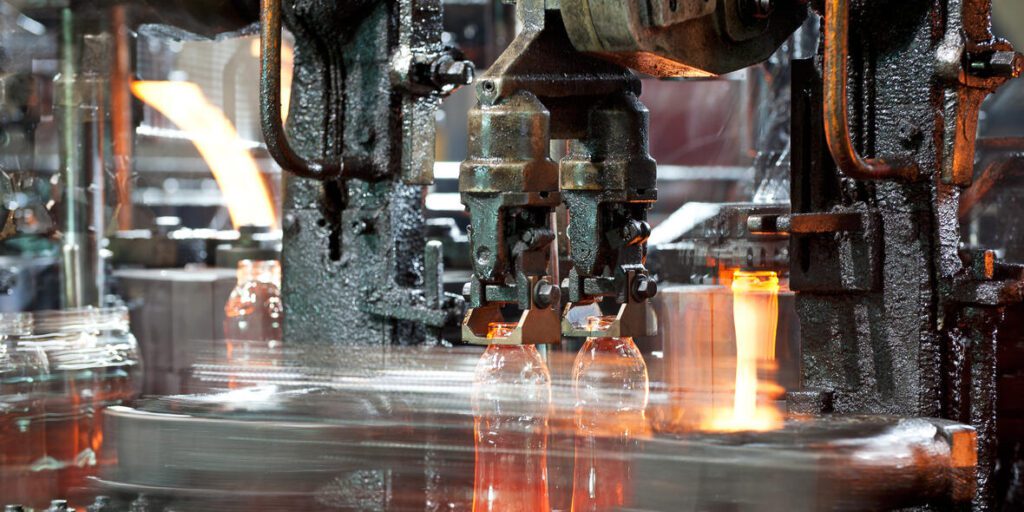As the glass and steel industries digitize and undergo the electrification of their operations, there are two emerging business opportunities for process OEMs (pOEMs) that support plant infrastructure upgrade initiatives.

The first opportunity is in the adoption of new furnace technologies. Most CO2 emissions result from fuel combustion for the melting process, which accounts for 75-85% of total emissions. Therefore, replacing fossil fuels in furnace operations is a direct means of quickly reducing CO2 emissions. Migrating from fossil fuel to green electricity in glassmaking, as well as from coal-fired blast furnaces to Electric Arc Furnaces (EAF) and Direct Reduced Iron (DRI) processes (using natural gas or green hydrogen) in the steel industry, is essential to achieving emissions reduction targets.
The second opportunity is a new software-driven energy-related operational services domain to drive revenue growth. These services enable end users to maintain operational uptime and higher process efficiencies while helping pOEMs build long-term annuity revenue streams.
A recent IDC survey report examines the role of energy in advancing industrial process performance and transformation and indicates that 80% of industrial respondents believe operational efficiency initiatives are “critical or important” to the success of their energy transition plans.
For many glass and steel manufacturers, unanticipated downtime is a leading business concern. For instance, downtime costs can reach up to $15,000 an hour in the glass industry if an issue affects all core machinery. On the other hand, across the metals industry, downtime cost estimates are as high as $187,500 per hour.
Organizations must change how they traditionally manage their operations to minimize downtime risks. A critical success factor is to develop the ability to gather and analyze meaningful process data more efficiently. By combining and analyzing operational and asset data, operators are in a much stronger position to:
- Detect performance anomalies earlier in the process.
- Predict when potential failures will occur.
Types of services that support electrification beyond project delivery
There are many ways pOEMs can work with their clients to furnish data-driven predictive services. One example involves initiatives surrounding power and process integration. This is a trend among many in the glass and steel industries who seek to reduce capital expenses (CapEx) by spending less on power and automation of physical assets. Such initiatives also deploy software tools to reduce operating expenses (OpEx) by streamlining engineering, operation and maintenance activities, potentially saving millions of dollars through increased production and lowered operating costs.
Consider the example of digital twin software tools, where AVEVA and ETAP software products enable engineers to simulate and test interactive plant power and automation environments. A pOEM can use a digital twin to test control logic through detailed graphics in a virtual commissioning scenario, for instance. Digital twins minimize potential design errors and streamline furnace build processes, making it easier to pinpoint where pOEMs can make efficiency gains and avoid downtime.
The distinction of digital twins over other traditional tools like CAD is the ability to simulate and document the impact of changes to a furnace’s design without having to invest in building any hardware prototype up-front. Schneider Electric works with pOEMs and end-user engineers from the early stages of the projects to apply digital twin concepts to power and process system design and operations.
From that point, power and process integration enables three services supporting electrification:
- Energy efficiency: Electrical and process automation systems have operated separately for decades, with most personnel not accountable for the energy consumed when running their operations. The convergence of power and process automation can create production KPIs to reward efficient energy. Organizations can lower overall carbon emissions by measuring operators on their productivity and energy efficiency. Schneider Electric can provide pOEMs the ability to offer monitoring as a service to their end-user customers.
- Asset performance and equipment health: Software-driven digitized asset performance management tools collect equipment performance data and provide operators with insights to enable OpEx reductions. In addition, asset process change simulations via tools such as digital twins provide visibility and predictability for data-based power and process decisions to gauge their effects on one another through a single view.
- Root cause analysis and incident repair: Integrating software-based predictive asset management of power infrastructure into broader management programs, pOEMs can support their end users with tools enabling root cause analysis of automation and electrical system-related issues and predictive maintenance capabilities. For example, automated anomaly alarms would allow operators to spend less time analyzing the problem and restart the process more rapidly. These capabilities are essential in electrification, which places more electrical-based assets in mission-critical roles.
For more information
To learn more about how pOEMs can help glass and steel manufacturers to accelerate their carbon emissions reductions and reduce their energy costs, download the Green Steel and Green Glass handouts.



